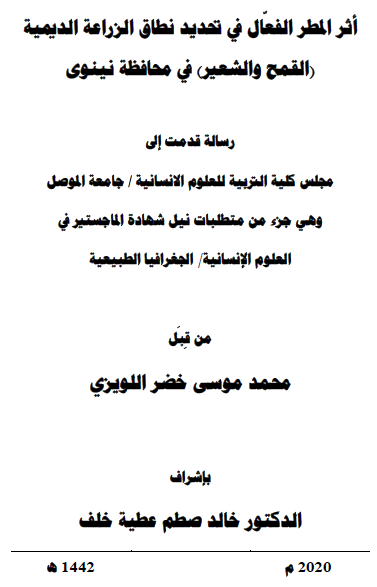أثر المطر الفعّال في تحديد نطاق الزراعة الديمية القمح والشعير في محافظة نينوى
رسالة مقدمة إلى
مجلس كلية التربية والعلوم الإنسانية / جامعة الموصل
وهي جزء من متطلبات نيل شهادة الماجستير
في العلوم الإنسانية / الجغرافيا الطبيعية
من قبل
محمد موسی خضر اللويزي
بإشراف
الدكتور خالد صطم عطية خلف
1442هـ - 2020م
The impact of effective rainfall on determining the domain of rainfed agriculture(wheat and barley) in Nineveh Governorate
To
The Council of the Education College for Human Sciences/University of Mosul As a partial fulfillment of the Requirements for the Master Degree In Humanity Sciences/ Natural Geography
Submitted by
Mohammed Musa khadr Al-Lewizy
Supervised by
Dr.Khalid Satam Atiyah Khalaf
2020 A.D. - 1442 A.H.
Abstract
The study is concerned with extracting the values of effective rain and its impact on the change of the line of demagogic agriculture in Nineveh governorate and the factors affecting it, such as temperature, evaporation/potential erosion characteristics and the water-climate balance and its relationship to identifying the most suitable areas for wheat and barley cultivation as they are among the most important strategic food crops in the country on which food security depends entirely on them, and the problems and constraints they face as one of the largest Iraqi provinces growing crops for the two crops.
The rainfed agriculture farming line varies during the study period depending on the fluctuation of Rainfed agriculture and the impact of other factors, which is reflected in the decrease in production on the one hand and the difficulties facing agriculture in unsecured areas, causing a loss to farmers on the other hand, as we highlight many problems in agriculture in marginal areas, in which the effective rain line changes, exposing them to the conditions of wind erosion and soil ablation.
Crop WAT and the use of the Benman Monteith FAO equation in 1998 were based on study area stations (Mosul, Rabia, Tal Afar, Sinjar, Tal Abta, Al-Baaj) to extract effective rain values and extract evaporation/possible evaporation/relief values from the amount of rain, which indicates a water deficit, especially during autumn and spring due to high temperature and increased evaporation, while the water deficit in the winter months varies between the stations mentioned.
The climate record of the study area stations for the duration (1988-2018) has been adopted and the results of effective rain for this period have shown a variation in its quantities during the months and seasons between the climatic stations, due to the variation of the elements of the climate (solar radiation, temperature, humidity, wind) from one region to another. In view of the variation of other natural factors, separate periods of time (1989 _ 1998 _ 2008 _ 2018 ) were chosen to calculate the effective rain and clarify its difference from season to season and its impact on the quantities of agricultural production by creating a relationship between The government's support Create a relationship between production and effective rain.
The results showed that the areas in the north of the province and parts of Sinjar district represent the guaranteed area, while the semi-guaranteed areas represented parts of the southern and western province of Mosul and some parts of Tal Afar and Sinjar and limited parts of the north of Al-Baaj and Hadar, while the areas not guaranteed by the rains included most of the remaining areas of the urban and ivory courts.
تحميل الرسالة
⇊
👇
👇
👈 mega.nz
👇
👈 top4top
👇
👈 4shared
⇊
👇
قراءة و تحميل
👇
⇊
👇








